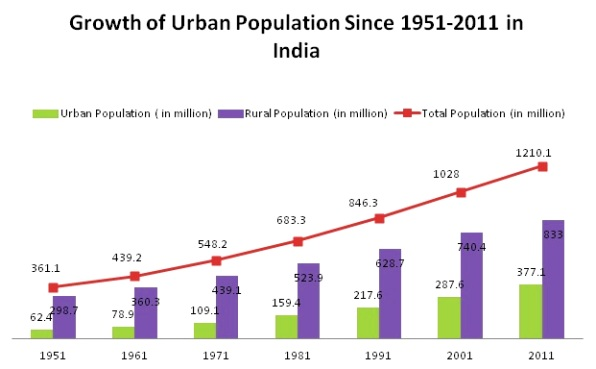Indian Society
'Good' Urbanisation
This article is based on Why India needs 'good' urbanisation which was published in the Indian Express on 20/09/2021. It talks about the issues of urbanisation and how ‘good’ urbanisation can resolve such issues.
Cities are a technology for poverty reduction; New York City’s GDP equals that of Russia with 6% of the people and 0.00005% of the land.
Covid-19 has catalysed a naive or hypocritical romanticism of villages that believes cities are undesirable technology because of their hostility to migrants, infection hotspot tendency, and diminished centrality to the future of work due to digitisation.
However, Covid-19 can be seen as an opportunity to catalyse good urbanisation by empowering our cities with more power and funds.
Debate — The Wizard vs The Prophet
- The post-Covid debate of cities as “desirable or undesirable” technology mirrors a 1960s debate about food chronicled in the wonderful book -The Wizard and the Prophet by Charles Mann.
- Norman Borlaug — the wizard — is a Nobel-winning scientist who believed science and technology will overcome challenges and he kickstarted the agricultural Green Revolution.
- William Vogt — the prophet — believed that prosperity would lead humans to ruin without cutting back and he kickstarted the environment movement.
- One says innovate; the other says retreat.
Is Urbanisation a Solution or Problem
- Urbanization yields several positive effects if it happens within the appropriate limits. Some of the positive implications of urbanization, therefore, include the creation of employment opportunities, technological and infrastructural advancements, improved transportation and communication, quality educational and medical facilities, and improved standards of living.
- However, extensive urbanization mostly results in adverse effects.
- Urbanization attracts people to cities and towns which leads to a high population increase. With the increase in the number of people living in urban centers, there is a continued scarcity of houses.
- The megacities — 10 million-plus populations — are unpleasant places to live for people who are not rich or powerful.
- The problem of joblessness is highest in urban areas and it is even higher among educated people. It is estimated that more than half of unemployed youths around the globe live in metropolitan cities.
- The cost of living in urban areas is very high. When this is combined with random and unexpected growth as well as unemployment, there is the spread of unlawful resident settlements represented by slums and squatters.
- Twenty-six of the world’s 33 megacities are in developing countries because their rural areas lack rule of law, infrastructure and productive commerce.
- Also there is no denying that even our non-megacities have inadequate planning, non-scalable infrastructure, unaffordable housing, and poor public transport.
- However, Megacities are not always cursed. Tokyo has a third of Japan’s population but planning and investments have ensured that essential workers like teachers, nurses, and policemen rarely commute two hours.
- The most insightful metric for city quality came from Italian physicist Cesare Marchetti who suggests that 30 minutes has been the most acceptable — or shall we say civilised — commute through history (even as the method changed from walking to horses to bicycles to trains to cars).
- The Marchetti constant is almost impossible in Bengaluru where taxi and auto speeds average 8 km/hour.
Major Issue of Urbanisation in India: Weak Local Urban Bodies
- The annual spend of the central government is about Rs 34 lakh crore and of 28 state governments is about Rs 40 lakh crore. But the 15th Finance Commission estimates 2.5 lakh plus local government bodies only spend Rs 3.7 lakh crore annually.
- This apartheid has many reasons.
- Power: Local government is curtailed by state government departments in water, power, schools, healthcare, etc (property tax collection would be 100% if municipal bodies supplied water).
- Independence: Only 13% and 44% of the budget of rural and urban bodies was raised by themselves.
- Structure: A Union ministry controlling finance and governance of the states would be unacceptable by the States but the Department of Local Self Government in the states has almost unlimited powers (suspension/removal of mayors and other elected representatives or supersession of elected local bodies is almost routine in most states).
- Having separate central rural and urban ministries distorts policy.
- Lack of Good Leadership: The lack of power and resources sets off a vicious cycle of decline because ambitious and talented individuals aren’t attracted to city leadership.
Way Forward — Need For Good Urbanisation
- For Socio- Economic Justice: Good urbanisation is crucial to delivering economic justice for women, children and other vulnerable sections of the society.
- Poor quality urbanisation has meant men-only migration, leaving the women with all the hard labour of farm work, raising the children, and looking after in-laws, while having virtually no recourse to health services, or to even emotional support of the spouse.
- Village children going to abysmal-quality government schools without bilingual possibilities places them at a disadvantage in English-dominated entrance tests for professional courses and civil services.
- Though not great by any standards, the quality of both healthcare and education in cities remains better than villages by miles.
- Redeveloping Small and Medium Cities: There is no denying that even our non-megacities have inadequate planning, non-scalable infrastructure, unaffordable housing, and poor public transport.
- Thus it is impossible to have good urbanisation without focussing on the small and medium cities.
- Getting Power and Funds to Cities: Good urbanisation needs chief ministers to sacrifice self-interest. Their reward will be the hopes of millions waiting for high-quality jobs and opportunities.
- India is lucky that Norman Borlaug prevailed over William Vogt in the food technology debate.
- As the post-Covid urbanisation debate gains momentum, we hope the wizards will again prevail over the prophets.
|
Drishti Mains Question Covid-19 reinforces that good urbanisation is our most powerful technology for poverty reduction. Comment. |





